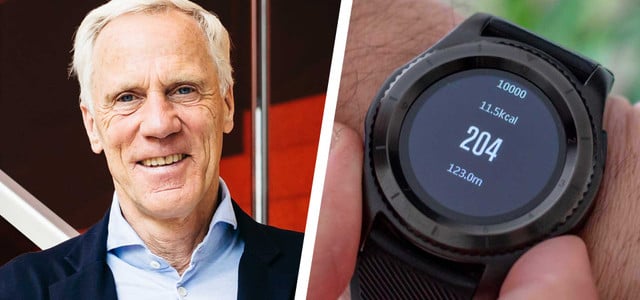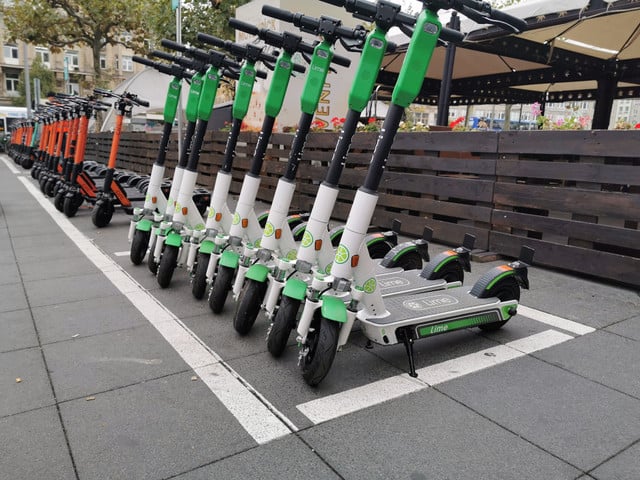
Getting more exercise is a popular New Year’s resolution. But how much exercise is healthy – and does it really have to be 10,000 steps a day? Sports and health expert Prof. Ingo Froboese recommends a different value and gives sports tips for all fitness levels.
Going for walks is considered healthy – even those who are not athletic can regularly stroll through nature and get some exercise. But is walking good for your own fitness? That depends, Ingo Froboese explains to Utopia. He is a professor for prevention and rehabilitation in sport at the German Sport University in Cologne and heads an institute for movement therapy. He regularly provides information on sports and health in his books and on his blog. According to the sports scientist, there are many good reasons for going for walks and against sitting for long periods of time. But not everyone gets fit. And it doesn’t have to be 10,000 steps – the expert recommends a different value instead.
Ingo Froboese in an interview: “Going for a walk can make you fitter – under certain conditions.”
Utopia: In your books you recommend going for walks regularly. What are the main benefits to be gained from it?
Ingo Froboese: Anyone can go for a walk, it’s a good start to a healthier lifestyle. As a rule, I move around in nature, so I come into contact with air, light and temperature. This stimulates the body and can also provide mental relief. Going for a walk can also make you fitter – under certain conditions.
Which are they?
Normal strolling is often not enough to train the body. This requires an increased heart rate and respiratory rate. To reach these, most must at least walk faster than they normally would. Those who are untrained can benefit from such walks. But athletes no longer get into a training situation when they go for a walk. For example, running is a good option for them to train their own fitness.
So whether I run or walk better depends on my performance level. How can you correctly assess your own fitness?
Just pay attention to your own breathing. It is best to inhale once for every four steps and exhale once for every four steps. This is how you supply your body with enough oxygen. If you are well trained, you will develop such a breathing rate while running. If that doesn’t work, you should stick to walking for now. And that quietly for a while. If you haven’t done much sport before, you should go for a walk for a few weeks before you start running.
How come?
Joints, tendons, bones and other large structures of the body need 4 to 6 months to get used to the new active life. In order not to damage them, you should slowly increase the load. If you overdo it with the training, you will notice it the morning after at the latest, then you will feel sore muscles or joint pain. In addition, the heart rate is often four to six beats too high the next morning. Then you should take it easy next time.

“Not everyone needs to walk 10,000 steps a day to stay fit.”
Talking about a lot of walking: Mr Froboese, what do you think of the well-known standard of 10,000 steps per day?
This number is not a guideline, but an advertising slogan from 1964. At that time the Olympic Games were taking place in Tokyo and the Japanese company Yamasa advertised their first pedometer. Translated, this meant “10,000 steps” – because 10,000 was the largest number that the device could display. Posters advertised walking 10,000 steps to stay fit. Since then, the value has remained as a recommendation, but without any scientific basis.
But does it make sense from a health perspective to walk 10,000 steps a day?
On average, people in Germany only walk around 5,000 steps a day. This is too little. But not everyone needs to walk 10,000 steps a day to stay fit.
For most of us, the value is set way too high. In normal everyday life, without sport, I can’t manage 10,000 steps either. You would have to walk 5 to 6 kilometers to reach the value, which is quite a distance.
What would you advise then, how much should we move every day?
There is not a single benchmark for this, you have to consider it individually. I would advise observing how many steps you take in everyday life – for example with the help of a pedometer app. In the days that follow, you can try to walk 3,000 more steps than you normally do. If you only move an average of 3,000 steps, you can already do twice as much. If you already walk 7,000 steps anyway, you can try to crack 10,000 steps.
Do I need a pedometer app permanently? Sports scientist Froboese advises against it
Pedometer apps are sometimes controversial for data protection reasons. Without a pedometer, how do we know if we’re moving enough?
You don’t necessarily need a pedometer to measure steps. You can just watch the distance. How many meters do I cover in 10,000 steps? On average, this is about 6 kilometers. The exact distance depends on your own step length. If you want to know exactly, you can simply measure it.
So are such apps superfluous?
Movement apps convey a feeling for one’s own body. And they motivate people to exercise by rewarding them – for example with digital awards. But do I really need a medal from Apple in the evening? No. I just need a feel for my own body. Your body will tell you when you’ve been too inactive.
How is that expressed?
Many people experience restricted mobility in everyday life as well as muscle and joint pain. The neck and back are very often affected by this during a sedentary activity. Chronic fatigue, shortness of breath and an ailing psyche can also indicate that the organism is lacking in movement and activity.
And in old age? How much exercise is appropriate? Should you cut it short?
No. Age is often used as an excuse, but when it comes to walking it is not an obstacle at all. On the contrary: the older you get, the more important exercise is – it helps to stay mobile. Walking is one of the best forms of exercise for seniors. It is even more important to train the muscles. You need this even more as you get older. Certain training exercises such as the “hacker” can help with this. [Anmerkung der Redaktion: Die Übung wird in diesem Video erklärt.] Anyone who sits too much and neglects exercise risks damage to their health – at any age.
Too much sitting affects the brain
Why is sitting so unhealthy?
There are numerous reasons for this. One of the most important is that body cells are not supplied with sufficient nutrients if you sit too much. Physical activity stimulates the metabolism. If we move too little, important nutrients and vital substances are no longer sufficiently transported in the body. This has an impact on the brain: Sitting too much makes us more and more tired and lethargic and we lose vitality. It also allows us to age faster because sitting for long periods of time can have negative effects on certain parts of our DNA. On the other hand, those who create a balance through an active end of the day prevent these changes. Researchers at the University of California were able to prove this in 2017.
Many people spend a large part of their everyday life sitting.
That’s correct. We have more and more comfort at our disposal. But that is at the expense of our health. For example, you can see more and more e-scooters and e-bikes on the streets. Some people may use them to replace a car ride. However, many of them cover distances that they would otherwise have walked. E-mobility is becoming more and more diverse, but it also takes away incentives to move.

Ingo Froboese gives tips for more exercise in everyday life
What can you do to move more in everyday life?
There are three areas of our everyday life in which we can move: work, transport and leisure. Most of us sit at work. Transport is also becoming more and more obsolete. Then the only options left are exercise in your free time. But that’s not fun for everyone, some don’t have access to it.
Exercise should be integrated into different areas of everyday life. For example, you can use the lunch break at work to go for a walk. Or combine phone calls or meetings with friends with going for a walk in your free time. When it comes to transportation, there are numerous options: Walk to the next station instead of waiting if you miss the bus. Use the stairs instead of the elevator. Even as an adult, you can still balance on the curb, jump on the little wall. In short: Look for and find more stress in everyday life. It’s not just healthy. Movement is also an important part of climate protection.
As the?
Physical activity is the most important energy resource for our society. Anyone who moves using their own muscle power is not dependent on means of transport that run on fossil fuels. Athletes also feel less cold because their muscle mass regulates body temperature better. That also saves resources.
Thank you for the talk.
Read more on Techzle.com:
- 7 fitness equipment for at home: Sport can also be done without plastic
- Everything okay? Here you will find better & more sustainable sports fashion
- 11 bad habits that we harm ourselves with